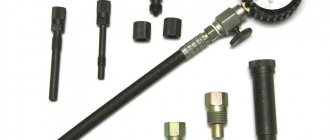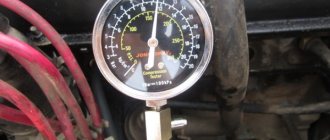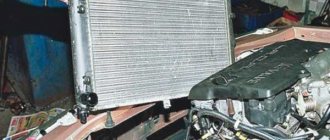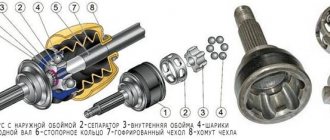05 February 2016 Lada.Online 77 552 10
How to quickly and accurately determine the condition of the engine? Check the compression in the cylinders! Is the engine running rough, you feel a loss of power, the consumption of engine oil or fuel has increased and the car has become difficult to start in cold weather? All of these problems may be caused by low compression in one or more cylinders.
Compression measurement
A compression test is carried out for a general assessment of the technical condition of the parts of the cylinder-piston assembly and the engine valve mechanism. The check is carried out with the engine warmed up to operating temperature. We increase the pressure in the engine fuel system (see “Replacing the fuel filter”) and do not replace the fuel pump fuse. We unscrew the spark plugs from the cylinder head (see “Checking the condition and replacing the spark plugs”). Disconnect the engine management system wiring harness assembly from the ignition coil wiring harness assembly (see “Engine Removal and Installation”).
Install the compressor tip into the spark plug hole of the cylinder head. We connect the wire terminal to the negative terminal of the battery. We turn the crankshaft with the starter while the accelerator pedal is fully pressed for 2-4 seconds (the pressure gauge should stop rising). We record the pressure gauge readings and relieve the pressure in the compressor. To correctly assess compression, the battery must be fully charged - the crankshaft speed when cranking must be at least 180 min -1. Similarly, we check the compression in other engine cylinders. The compression of a running engine should be between 11.0 and 13.0 bar, and the difference in cylinder readings should not exceed 2.0 bar. To find out the reasons for low compression, pour 10-15 cm 3 of engine oil into the cylinder through the spark plug hole and repeat the measurement. If, upon repeated measurements, the compression increases by more than 2.0 bar, the most likely cause of the malfunction is severe wear, blockage or breakage of the piston rings. If after filling the oil the pressure gauge readings do not increase, the valve discs most likely will not fit into the cylinder head sockets. This can occur if the valve actuator is malfunctioning, or if the valve poppets or seats are severely worn, burned, or damaged. The cause of the malfunction can only be definitively determined after disassembling the engine.
On new Lada Priora engines, the compression in each cylinder must be at least 16 atmospheres. And if, when replacing it, it turns out that in one or more cylinders these readings differ greatly from the maximum, then more thorough diagnostics of the engine is required and identification of the problems that caused such a decrease.
To check the compression on the Priora yourself, we will need:
- Candle head
- Extension
- Ratchet or crank
- Compressor
- Head 10 mm
Motor 126 and 127: working life, differences
These engines on Priora had a displacement of 1.6 liters (or 1596 cm3). Optimal for city sedans, the engine size of the Lada Priora gave a good combination of dynamics and consumption: along with very decent acceleration, fuel consumption does not exceed sky-high numbers. Both engines received good marks, because the car behaved perfectly in the city and on the highway.
In fact, the 126 Priora engine became the first sixteen-valve engine for this model, and the 127 is a modified version, “overclocked” by AvtoVAZ designers. In addition to the same engine displacement, they have other identical characteristics. The in-line type of arrangement of four cylinders provides a simplified design that can be repaired on your own.
The distributed multipoint injection system is involved in creating a good, rich fuel-air mixture (a lean mixture can lead to breakdowns). The cylinder diameter is 82 mm, the piston stroke is 75.6 mm, the compression ratio is 11. The “engines” fall under the Euro 4 standard, they are powered by gasoline with an octane rating of 95.
The 126 engine for the Priora received the following characteristics: 98 hp. (72 kW at 5600 rpm), acceleration to 100 km/h in 11.5 seconds (with manual transmission), city consumption 9.1 l - 100 km (manual transmission), maximum torque - 145 Nm.
The 127 engine for the Priora was upgraded to the following figures: 106 hp. (78 kW at 5800 rpm), acceleration to 100 km/h in 11.5 seconds (with manual transmission), city consumption 8.9 liters per 100 km (with manual transmission), maximum torque – 148 Nm.
The difference may not seem so noticeable, but this is a very small but strong step in design on the part of AvtoVAZ (this is where the change to sixteen-valve “engines” with a volume of 1.6 liters ended). For a car of the Lada Priora class, the engine power was sufficient.
In the same block it is necessary to say about the operating temperature. An absolutely normal operating temperature is considered to be between 90 and 95 degrees Celsius. Further, when the car is being pushed in a traffic jam, is basking in the sun, or for some other reason, but can still work - from 97 to 110 degrees. The engine is slow in places and wears out a lot, but you can still get to your destination. A temperature below 90 degrees is a direct sign indicating that the car has not yet warmed up, and it is better to wait in place until the arrow points to the coveted 80-90 mark.
Operating a car at temperatures above 110 degrees is dangerous because the service life of the engine is noticeably reduced - hot parts undergo very severe wear, overcoming the force of friction.
In general, the service life of the Lada Priora engine with a normal driving style and careful treatment is 200,000 km - after this mark the time comes when the “engine” requires major repairs. AvtoVAZ mentioned the timing belt separately as a recommendation, saying that it needs to be checked every 100,000 km (many car enthusiasts talk about the figure of 50,000 km).
Read more: Gazelle Next wheel alignment angles
All Lada engines have a problem, and it is related to the valves, which will be discussed further.
Procedure for checking compression on a 16-valve Priora engine
We will immediately show how to perform this procedure on a 16-valve engine, since on an 8-valve engine everything is much simpler and no questions will arise.
- The first step is to warm up the engine to operating temperature.
- Remove the top plastic cover
- Unscrew the bolts securing the ignition coils and remove them
- Remove all 4 spark plugs
Now you need to turn off the power to the coils by disconnecting the wire block, as shown in more detail in the photo below.
You can now screw the pressure gauge fitting into the cylinder 1 spark plug hole, which is clearly shown below.
Now you need to turn the starter while pressing the accelerator pedal all the way. At this stage, you need to fix the device so that it is securely fixed, or ask an assistant to hold it in their hand. It is necessary to crank the starter until the pressure stops increasing.
Typically, 4 starter revolutions are sufficient to create maximum pressure in the cylinder. At the same time, the photo shows that the compression in the first cylinder is 16 atm. In the same way we take measurements on the other three cylinders. But before you unscrew the device, you need to release the pressure by pressing the appropriate reset button.
If during the measurement it turns out that the compression is practically the same in all cylinders, and is also at least 12 atmospheres (at least), then this can be considered the norm. Although ideally it should not fall below 13-14 on the 21126 engine.
If it is discovered that the compression varies greatly in one or more cylinders (by atmosphere), it is worth conducting additional engine diagnostics. We fill the problematic cylinder with several “cubes” of clean motor oil, then measure again. If in the second case the compression has increased, most likely the reason is in the piston rings, that is, wear.
If the pressure remains the same, that is, has not changed, then most likely the reason is in the valves or other problems with the cylinder head.
see also
Comments 29
I bought a viburnum with a 126 engine not so long ago, compression 9.6,14,12,14, mileage 127 thousand, I pour 150-200 grams of oil every week, and the question is, is the problem in the valves or does the engine need to be completely rebuilt?
If the compression differs by more than 1, it means there is a problem with the piston. Maybe the rings are stuck, maybe something else
good compression, don’t listen to anyone) I have one myself and the mileage is 100 thousand) when the rings are stuck, it will be visible to the naked eye from the exhaust fog will go around)
13 is very good for a 126 engine, the compression ratio from the factory is 11! Increased compression with in your case, you need to figure out the cause, fortunately there are few of them! Find a normal motor mechanic.
In 126 engines this is normal. On my Priora the same thing happened even after 92 thousand. mileage I was interested in the mechanics, they said this compression is due to the lightweight piston. And oil consumption in these engines seems to be the norm, although some write, from replacement to replacement. An acquaintance took a new one from the dealership, after the first replacement it began to eat up, and someone drills additional holes in the piston, in the oil scraper groove when replacing the caps. They say it helps.
There shouldn’t be any oil-guzzling at all! There is no need to drill short pistons, because... They are already designed correctly!
Compression is quite good, the only question is that the oil scraper rings could have worn out, due to a good film of oil, that’s why the compression is so good...
13.8 in each cylinder was
Meryl the other day. 16 and further the pressure gauge needle goes off the scale











